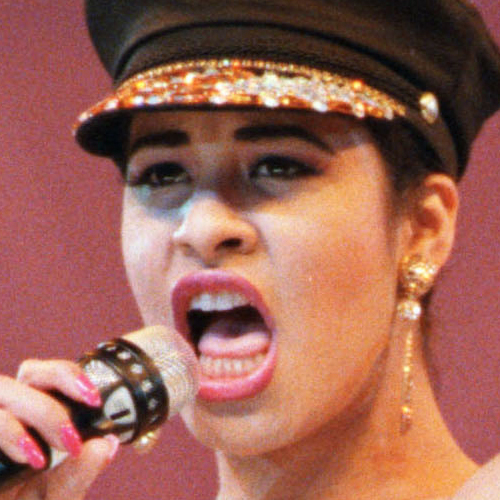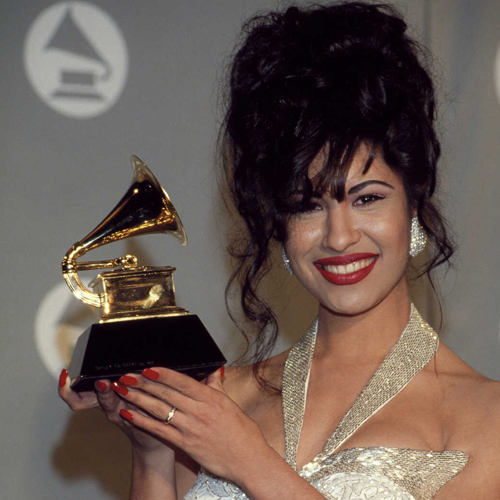
Selena
Born: 16 April 1971
Died: 31 March 1995 (23 Years)
Cause: At 11:48 a.m. (CST), Saldívar got a gun from her purse and pointed it at Selena. As Selena attempted to flee, Saldívar shot her once on the right lower shoulder, severing the subclavian artery and causing a severe loss of blood. Critically wounded, Selena ran towards the lobby, leaving a 392-foot (119 m)-long trail of blood. She collapsed on the floor as the clerk called the emergency services, with Saldívar still chasing after her and calling her a "bitch". Before collapsing, Selena named Saldívar as her assailant and gave the number of the room where she had been shot.
Died: 31 March 1995 (23 Years)
Cause: At 11:48 a.m. (CST), Saldívar got a gun from her purse and pointed it at Selena. As Selena attempted to flee, Saldívar shot her once on the right lower shoulder, severing the subclavian artery and causing a severe loss of blood. Critically wounded, Selena ran towards the lobby, leaving a 392-foot (119 m)-long trail of blood. She collapsed on the floor as the clerk called the emergency services, with Saldívar still chasing after her and calling her a "bitch". Before collapsing, Selena named Saldívar as her assailant and gave the number of the room where she had been shot.

Selena
Selena Quintanilla Pérez (April 16, 1971 – March 31, 1995), known mononymously as Selena, was an American singer and fashion designer. Called the "Queen of Tejano music", her contributions to music and fashion made her one of the most celebrated Mexican-American entertainers of the late 20th century. In 2020 Billboard magazine put her in third place on their list of "Greatest Latino Artists of All Time", based on both Latin albums and Latin songs chart. Media outlets called her the "Tejano Madonna" for her clothing choices. She also ranks among the most influential Latin artists of all time and is credited for catapulting the Tejano genre into the mainstream market.
The youngest child of the Quintanilla family, she debuted on the music scene as a member of the band Selena y Los Dinos, which also included her elder siblings A.B. Quintanilla and Suzette Quintanilla. In the 1980s, she was often criticized and was refused bookings at venues across Texas for performing Tejano music—a male-dominated music genre. However, her popularity grew after she won the Tejano Music Award for Female Vocalist of The Year in 1987, which she won nine consecutive times. She signed with EMI Latin in 1989 and released her self-titled debut album the same year, while her brother became her principal music producer and songwriter.
Selena released Entre a Mi Mundo (1992), which peaked at number one on the US Billboard Regional Mexican Albums chart for eight consecutive months. The album's commercial success led music critics to call it the "breakthrough" recording of her musical career. One of its singles, "Como la Flor", became one of her most popular signature songs. Live! (1993) won Best Mexican/American Album at the 1994 Grammy Awards, becoming the first recording by a female Tejano artist to do so. In 1994, she released Amor Prohibido, which became one of the best-selling Latin albums in the United States. It was critically acclaimed as being responsible for Tejano music's first marketable era as it became one of the most popular Latin music subgenres at the time.
Selena was shot and killed on March 31, 1995, by Yolanda Saldívar, her friend and the former manager of her Selena Etc. boutiques. Saldívar was cornered by police when she attempted to flee and threatened to kill herself but was convinced to give herself up. She was convicted of murder and sentenced to life in prison with possible parole after 30 years. Two weeks later, George W. Bush, then-governor of Texas, declared April 16 as Selena Day in Texas. Her posthumous crossover album, Dreaming of You (1995), debuted atop the Billboard 200, making Selena the first Latin artist to accomplish this feat. In 1997, Warner Bros. released Selena, a film about her life and career, which starred a then-unknown Jennifer Lopez as Selena, catapulting Lopez into fame. In 2020, Netflix released Selena: The Series starring Christian Serratos. Selena has sold around 18 million records worldwide, making her one of the best-selling female artists in Latin music.
On April 1, Bayfront Plaza in Corpus Christi held a vigil which drew 3,000 fans. During the event, it was announced that a public viewing of the casket would be held at the Bayfront Auditorium the following day. Fans lined up for almost a 1 mile (1.6 km). An hour before the doors opened, rumors that the casket was empty began circulating, which prompted the Quintanilla family to have an open-casket viewing. About 30,000 to 40,000 fans passed by Selena's casket. More than 78,000 signed a book of condolence. Flowers for the casket viewing were imported from The Netherlands. At the request of Selena's family, video and flash photography was banned.
On April 3, 1995, six hundred guests—mostly family members—attended Selena's burial at Seaside Memorial Park in Corpus Christi, Texas, which was broadcast live by a Corpus Christi and San Antonio radio station without the consent of her family. A Jehovah's Witness minister from Lake Jackson preached in English, quoting Paul the Apostle's words in 1 Corinthians 15. Hundreds of people began circling the area in their vehicles. Among the celebrities who attended Selena's funeral were Roberto Pulido, Bobby Pulido, David Lee Garza, Navaira, Laura Canales, Elsa Garcia, La Mafia, Ram Herrera, Imagen Latina, and Pete Astudillo.A special mass held the same day at Los Angeles Sports Arena drew a crowd of 4,000.
(wikipedia)
The youngest child of the Quintanilla family, she debuted on the music scene as a member of the band Selena y Los Dinos, which also included her elder siblings A.B. Quintanilla and Suzette Quintanilla. In the 1980s, she was often criticized and was refused bookings at venues across Texas for performing Tejano music—a male-dominated music genre. However, her popularity grew after she won the Tejano Music Award for Female Vocalist of The Year in 1987, which she won nine consecutive times. She signed with EMI Latin in 1989 and released her self-titled debut album the same year, while her brother became her principal music producer and songwriter.
Selena released Entre a Mi Mundo (1992), which peaked at number one on the US Billboard Regional Mexican Albums chart for eight consecutive months. The album's commercial success led music critics to call it the "breakthrough" recording of her musical career. One of its singles, "Como la Flor", became one of her most popular signature songs. Live! (1993) won Best Mexican/American Album at the 1994 Grammy Awards, becoming the first recording by a female Tejano artist to do so. In 1994, she released Amor Prohibido, which became one of the best-selling Latin albums in the United States. It was critically acclaimed as being responsible for Tejano music's first marketable era as it became one of the most popular Latin music subgenres at the time.
Selena was shot and killed on March 31, 1995, by Yolanda Saldívar, her friend and the former manager of her Selena Etc. boutiques. Saldívar was cornered by police when she attempted to flee and threatened to kill herself but was convinced to give herself up. She was convicted of murder and sentenced to life in prison with possible parole after 30 years. Two weeks later, George W. Bush, then-governor of Texas, declared April 16 as Selena Day in Texas. Her posthumous crossover album, Dreaming of You (1995), debuted atop the Billboard 200, making Selena the first Latin artist to accomplish this feat. In 1997, Warner Bros. released Selena, a film about her life and career, which starred a then-unknown Jennifer Lopez as Selena, catapulting Lopez into fame. In 2020, Netflix released Selena: The Series starring Christian Serratos. Selena has sold around 18 million records worldwide, making her one of the best-selling female artists in Latin music.
On April 1, Bayfront Plaza in Corpus Christi held a vigil which drew 3,000 fans. During the event, it was announced that a public viewing of the casket would be held at the Bayfront Auditorium the following day. Fans lined up for almost a 1 mile (1.6 km). An hour before the doors opened, rumors that the casket was empty began circulating, which prompted the Quintanilla family to have an open-casket viewing. About 30,000 to 40,000 fans passed by Selena's casket. More than 78,000 signed a book of condolence. Flowers for the casket viewing were imported from The Netherlands. At the request of Selena's family, video and flash photography was banned.
On April 3, 1995, six hundred guests—mostly family members—attended Selena's burial at Seaside Memorial Park in Corpus Christi, Texas, which was broadcast live by a Corpus Christi and San Antonio radio station without the consent of her family. A Jehovah's Witness minister from Lake Jackson preached in English, quoting Paul the Apostle's words in 1 Corinthians 15. Hundreds of people began circling the area in their vehicles. Among the celebrities who attended Selena's funeral were Roberto Pulido, Bobby Pulido, David Lee Garza, Navaira, Laura Canales, Elsa Garcia, La Mafia, Ram Herrera, Imagen Latina, and Pete Astudillo.A special mass held the same day at Los Angeles Sports Arena drew a crowd of 4,000.
(wikipedia)

